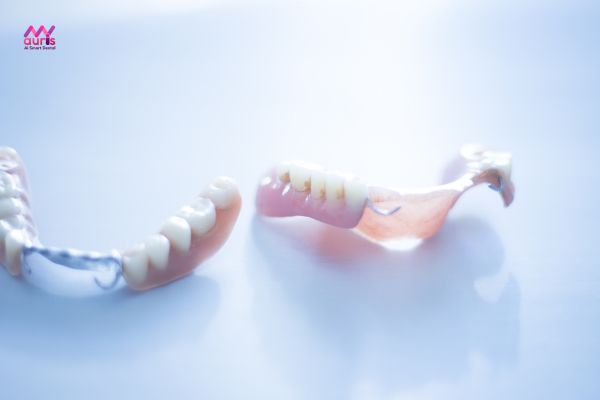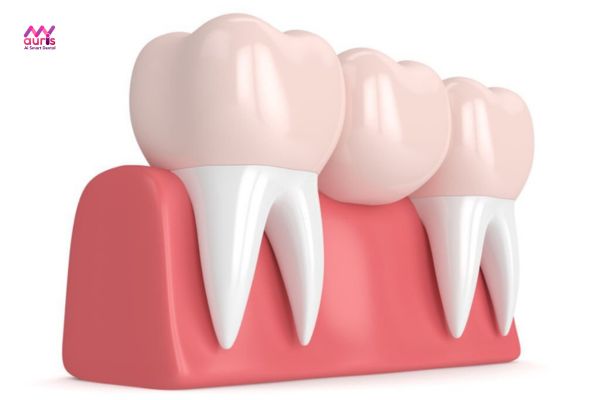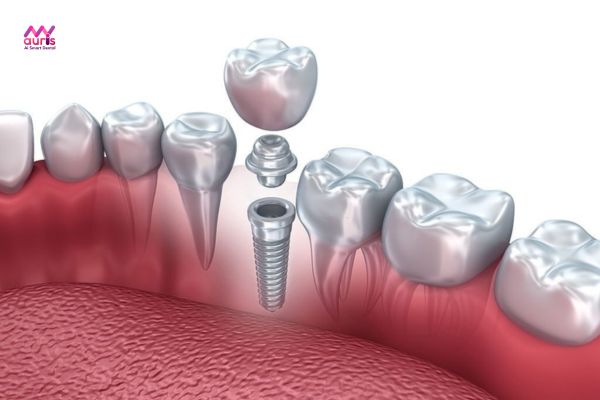For any reason, teeth are at risk of falling out or being lost. If there is no early remedy, it will greatly affect the function of teeth as well as cause many complications. Therefore, dental implants and dentures are one of the solutions that receive a lot of attention. To better understand the techniques of dental implantation and denture making for aesthetic restoration and chewing of teeth, let’s learn with My Auris dentistry through the following article.
What are dental implants and dentures?
Dental implants and dentures are concepts that refer to methods of restoring lost teeth. From there, dentures will fill the missing tooth space, providing aesthetics as well as restoring chewing and other functions of the teeth.
The fact that there are two phrases: implant and denture is due to the way many people use the words or name the method. For example, some people correctly use dentures, but some use them as dentures when talking about dental implants.

Dentures are made from many materials, which can be plastic, porcelain or metal. The teeth are crafted to have the same color as the teeth. Furthermore, the teeth are made according to the parameters, size, and proportions of each person’s real teeth.
These artificial teeth are planted into each person’s jaw using different dental implant techniques. Each technique has its advantages and disadvantages and different methods. Depending on your condition, needs, preferences and economic conditions, your doctor will advise you on the most suitable dental implant and denture method.
Methods of dental implants and dentures
Currently, there are 3 most popular methods of implanting dentures: dentures/removable dentures, bridges porcelain teeth and dental implants.
Making dentures with removable dentures
Removable dentures are a long-standing method of making porcelain teeth, widely used in restoring many missing teeth such as Loss of teeth in 1 jaw, loss of all teeth. Removable dentures are composed of a jaw base and denture teeth.
The jaw base can be plastic or metal frame, while the dentures pressed tightly on the jaw are made of plastic or porcelain. In terms of color and shape, they are crafted to resemble real teeth.
Day BeforePerhaps people are familiar with dentures that are full jaws, but nowadays, depending on the condition of missing teeth, they can be crafted accordingly. Therefore, there are still removable dentures for cases where few teeth are lost, such as 1-2 teeth.
Removable dentures have the same structure as dentures, however, to fix the teeth, there are additional metal hooks. Metal hooks hook onto neighboring real teeth to hold the dentures on the jaw.
Advantages
Tooth implants and removable dentures have the biggest advantage which is the cost savings because they are the lowest among dental implant methods. Furthermore, the implementation time is quick, only about 2-4 days to complete.
Disadvantages
Compared to today’s modern dental implant and denture methods, removable dentures have many disadvantages, especially in terms of aesthetics and chewing ability. Therefore, this method is often given priority to the elderly, who do not have high requirements for aesthetics, chewing, and especially whose teeth and health do not qualify for porcelain bridges or dental implants.
- After installing teeth or dentures on the jaw, it still covers the gap of missing teeth, but the jaw base and dentures do not look real. Therefore, it is easy to be detected as fake teeth.
- Restores low chewing ability, only about 30-40% of chewing force like real teeth. Therefore, it is necessary to limit foods that are too hard, too chewy, too flexible or require a lot of chewing force.
- Removable dentures/dentures only restore tooth crowns, do not affect tooth roots, so they cannot prevent jaw bone loss. Therefore, after a period of reduced jaw bone density, facial imbalance, sunken cheeks, wrinkled skin, premature aging, etc.
- Cleaning is inconvenient, if not cleaned thoroughly, it is easy to get bad breath. Or after a period of use, the fluid seeps into the base of the jaw causing an unpleasant odor.
- When newly made, the jaw will fit tightly to the jaw arch, but in a short time it will loosen and easily fall out, thus greatly affecting chewing and daily activities.
- Average lifespan is short, usually only using 3-5 years before needing to replace a new jaw.

Ceramic bridge – Porcelain bridge implant
Bridged porcelain dental implants are a fairly popular method of dental implants and dentures today. This is a fixed dental implant method chosen by many people, especially those who do not have the economic or health conditions for dental implants.
Bridged porcelain dental implants are also quite simple. The doctor will consider the condition and oral health, depending on the number of missing teeth, choose the appropriate number of supporting pillars. Then, grind the tooth post to a certain ratio to create a post to support the porcelain bridge above.
A porcelain dental bridge is a series of porcelain teeth consisting of adjacent porcelain teeth. The teeth have the same color, shape, and size as real teeth. Depending on the number of missing teeth, the number of teeth on the porcelain bridge corresponds. For example, if one tooth is lost, a porcelain bridge consists of 3 teeth with the 2 side teeth serving as pillars and the middle tooth filling the gap of the lost tooth.
Advantages
Tooth implantation with a porcelain bridge provides higher aesthetics than removable dentures. Because the color of porcelain teeth is more similar to the color of real teeth. Not only aesthetics, chewing ability is also higher, porcelain dental bridges restore about 60-70% of the chewing power of real teeth.
After losing teeth, planting a porcelain bridge early will help prevent misaligned teeth and make it easier to clean. Besides, porcelain bridge dental implants are also quick, only 2-4 days to complete.
Disadvantages
Besides the advantages,dental implants and dentures with porcelain dental bridges still have some disadvantages that people need to consider prompt:
- Initially, the porcelain bridge is tight and beautiful, but if you choose a metal ceramic crown, after a while the porcelain teeth oxidize, causing the gum line to blacken and lose aesthetics.
- Although the ability to chew is restored to a relatively high degree, after a period of time porcelain teeth recede and gums greatly affect chewing.
- Porcelain dental bridges only restore tooth crowns, so they cannot prevent jaw bone loss.
- The location underneath the porcelain bridge is difficult to clean. If not cleaned thoroughly, food debris and plaque will accumulate, creating an ideal environment for bacteria to invade and attack. From there, dental diseases arise and cause bad breath.
- There is impact and invasion of real teeth, so in the long term this tooth will also be weak and may fall out and lose teeth permanently.
- Only restore cases with few missing teeth because the porcelain bridge is too long and will not be effective. In particular, it is not possible to restore tooth number 7 because tooth number 8 is not qualified to be an abutment.
- The cost depends largely on the ceramic material butg generally costs quite a bit
- Average life expectancy is not high, usually 5-7 years.

Dental implants
In the Dental implants and dentures, dental implants or dental implants are the most optimal methods. This method is highly appreciated by experts because it brings many advantages and benefits over both removable dentures and porcelain bridges.
A dental implant is structured like a real tooth with an implant post made from titanium replacing the tooth root, a ceramic crown replacing the crown and an Abutment joint connecting the implant post and the ceramic crown.
To do this, the doctor will implant the implant into the jawbone at the location of the missing tooth. After the tooth post integrates with the jawbone to be as strong as a real tooth root, a porcelain crown will be installed on top to complete the tooth.
Advantages
The reason dental implants are highly appreciated and recommended by experts is because they bring many benefits to oral health:
- Extremely high aesthetics because the tooth is as complete as a real tooth
- Restores good chewing, up to 90% of the chewing power of real teeth, so you can chew comfortably and enjoy delicious food.
- Restoring both the tooth root and crown should prevent jaw bone loss from occurring
- The implant is made from titanium – a safe, hard, non-abrasive material with high biocompatibility, so it does not cause irritation or allergies in the oral cavity environment
- Easy to clean, prevents diseases, better protects oral health.
- Independent, non-invasive tooth implant method that affects neighboring teeth
- Long lifespan, up to 25 years on average. If cared for, cleaned well and properly, it will last forever.
Disadvantages
The biggest disadvantage of dental implants is the high cost. At the same time, this is pModern aromatherapy requires advanced machinery, equipment, techniques, and good expertise from the treating doctor to bring success.

Hopefully the information in the article aboutdental implants and dentures will help people better understand the methods. From there, consider the situation and choose the appropriate technique to restore lost teeth. Please contact My Auris Dental immediately for detailed advice, answers, and preferential programs for denture implant services.
Anh Thy





